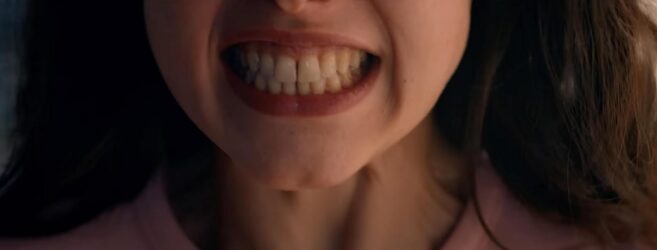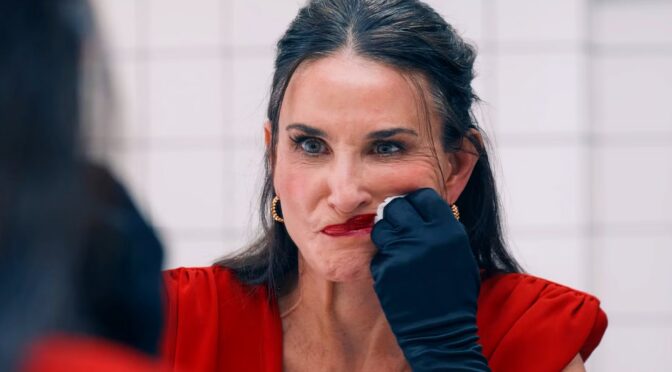Coralie Fargeat’s THE SUBSTANCE is a delirium-inducing concoction of numerous body horror films and literary influences, further combining an askew glance at fame and a gaudy gore aesthetic to an eye-catching effect. A resurgent performance from Demi Moore and an accomplished one from Margaret Qualley give the film enough momentum to carry Fargeat’s vision to the finish line, even if it is sagging in just about every way by the time it gets there.
Elisabeth Sparkle (Demi Moore) is the host of a popular daytime aerobics show. Her career has declined from the height of its Oscar-winning fame, a neat précis given via a fixed initial gaze on her star on The Hollywood Walk of Fame: where she once strode triumphantly, tourists now apologetically wipe dropped fast food from its cracked surface. Upon learning Dennis Quaid’s sleazy TV executive seeks to replace her on the show, an encounter with a young hospital worker leads her to seek out “the substance” via a mysterious phone call. A slick video promises a younger and better version of yourself, but you must shift your consciousness between each every seven days (“respect the balance”). This “better” version of herself is embodied by Margaret Qualley, who adopts the name (and apparent mononym) Sue as she pursues new fame.
To go over the specific mechanics of how Sue and Elisabeth come to share a world and mind would be to rob THE SUBSTANCE of the opportunity to maximise the impact of its toe-curling manifestation of a female mid-life crisis brought on by societal chauvinism. Although Fargeat’s film will sear retinas with its bulging masses of flesh and gaudy depiction of Sue’s rise to fame and the disgusting men that frame it, the film is also capable of more subtle buildup. The casting of Demi Moore as the fallen star is an especially fascinating and metatextual element given her comparatively light recent filmography compared to her pinnacle of fame in the 1980s and 1990s. The lighting conveys a mature grace as she sits disconsolately at a bar. She may not possess unblemished youth, but the care with which the film balances her beauty with her maturity renders the horrors that follow all the more tragic.
“Although Fargeat’s film will sear retinas with its bulging masses of flesh and gaudy depiction of Sue’s rise to fame and the disgusting men that frame it, the film is also capable of more subtle buildup.”

The film ruptures that singular existence apart, birthing Sue into the world via a fearless gaze and tearing of flesh that – whilst obviously inspired by the likes of Cronenberg – seems to share the boldness and lingering but unglamorous objectification of Julia Durconau’s RAW. At the same time, THE SUBSTANCE skirts to the edge of evoking 2001: A SPACE ODYSSEY in sequences birthing the other self, speaking to its greater braveness to invoke more obviously stylised imagery to deliver its effects. The flooring of the studios’ corridors has a clear echo of THE SHINING’s Overlook Hotel (complete with bloody third-act callback), and the shady alley where Elisabeth picks up new supplies of ‘the substance’ has the appearance of a mailroom adrift from this plane of existence. The stylisation extends to the film’s sound design, with every bodily contortion, spine rip, and visceral interaction resounding in agonising detail.
As the film settles into a body-swap dynamic, the camera notably leers at Sue during the sequences of her filming the new edition of the fitness show – having replaced her elder alter ego. The film’s gaze is satire to the point of caricature, and a viewpoint THE SUBSTANCE is keen to subvert and upend when Sue/Elisabeth’s paranoia rises about the durability of her Machiavellian biological scheme. As that progresses, the film morphs into a Dorian Gray concept made flesh, sent further off-kilter by how it presents this increasingly unhinged experience of its main character(s).
“The film’s gaze is satire to the point of caricature, and a viewpoint THE SUBSTANCE is keen to subvert and upend when Sue/Elisabeth’s paranoia rises about the durability of her Machiavellian biological scheme. As that progresses, the film morphs into a Dorian Gray concept made flesh…”
The amped-up and hyper-stylised take on the expectations of female beauty is extremely on the nose and ferociously confident. The film descends into an almost hilariously extravagant festival of gore and perhaps overextends itself. That confidence results in an overlong final chapter that is as hedonistic in its approach to gore as Sue is with her newfound youth or Elisabeth is with her spiralling self-worth. The plot point that marks this transition is beautifully and disgustingly observed, but the extended final segment somewhat reduces its horrifying impact.
However, unlike Elisabeth, THE SUBSTANCE does not tragically throw away all it has built in the pursuit of renewed and flashy notoriety. Even if the film starts to lose the neater focus it has for most of its runtime, the distinctive vision and delirious finale come full circle to the film’s opening in a bloodily satisfying manner.

